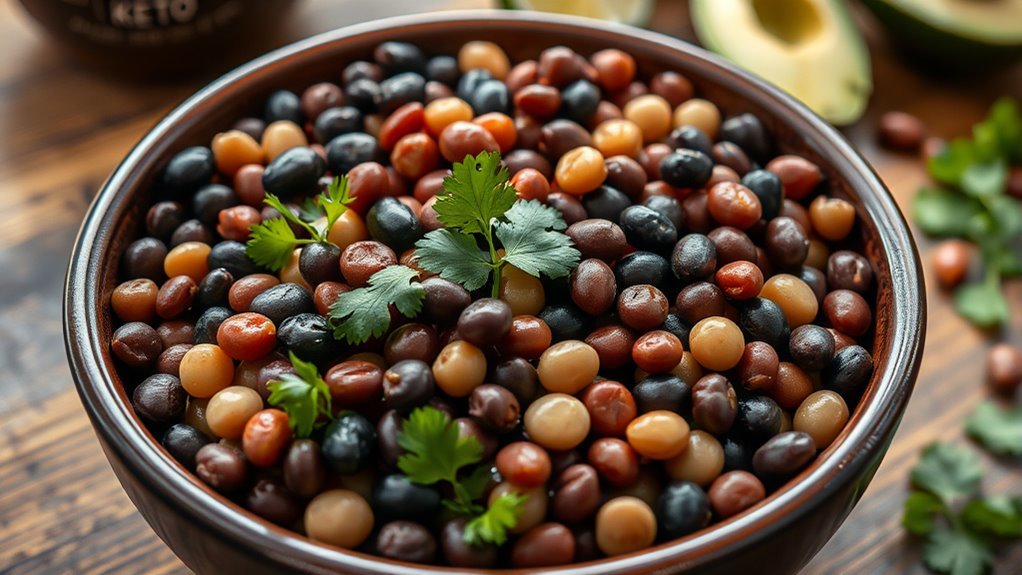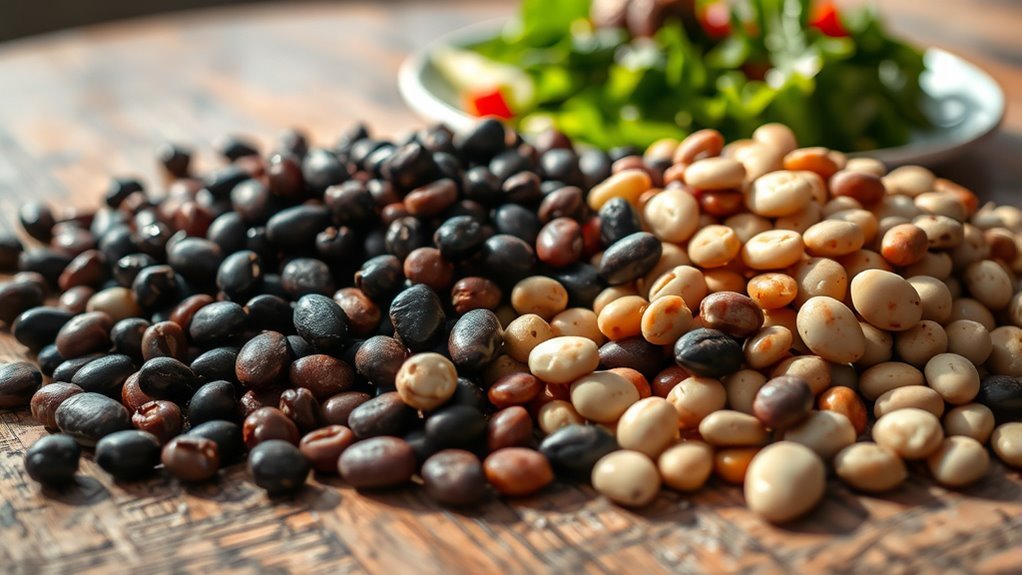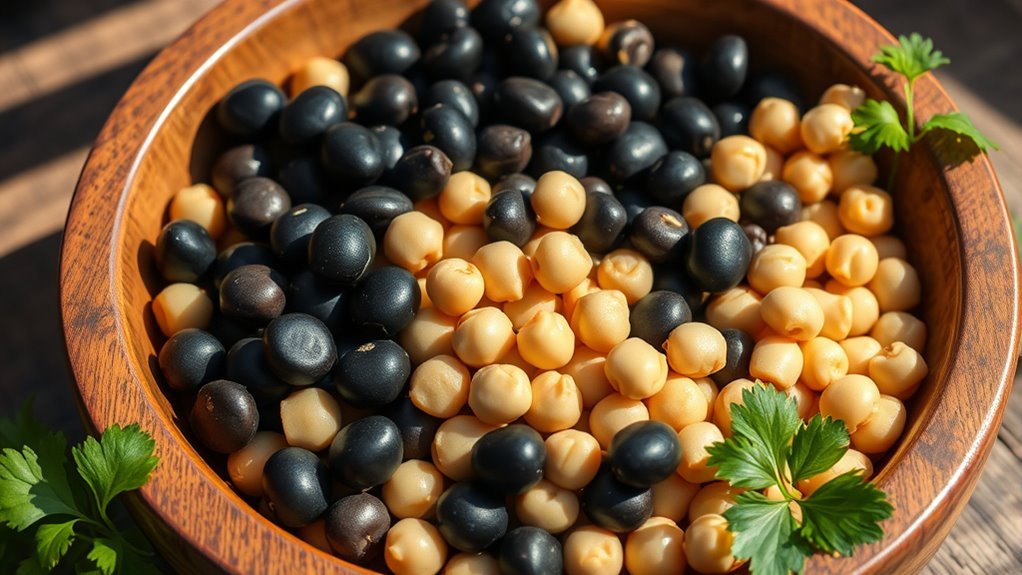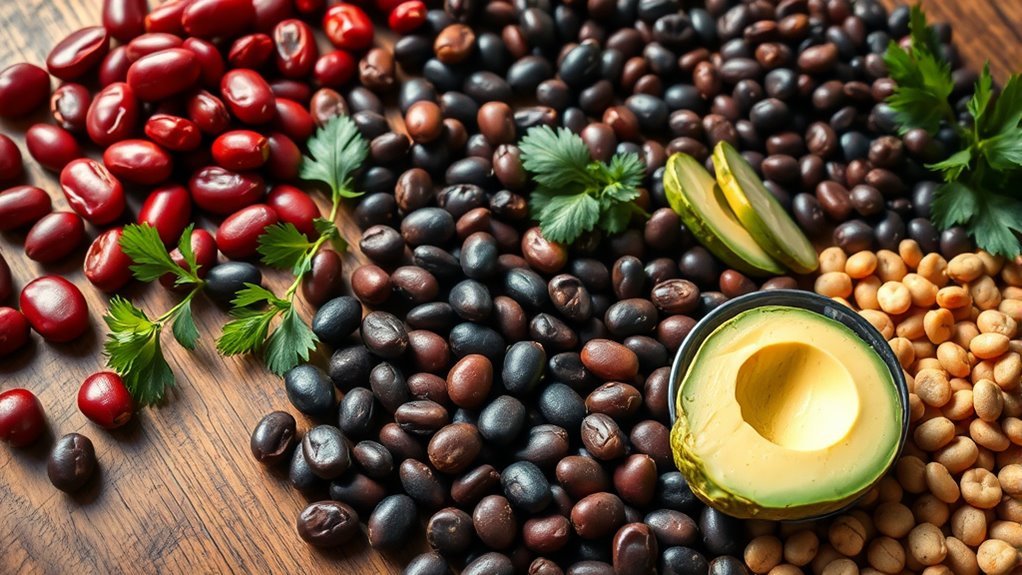Yes, you can eat beans on a keto diet, but you need to be cautious about their carb content. Low-carb varieties like black soybeans and green beans can fit into your daily limits, while others, like lentils and kidney beans, may be higher in carbs. Proper preparation, such as soaking or pressure cooking, can help reduce their carb impact. As you explore further, you’ll discover more tips on how to incorporate beans effectively into your meals.
Understanding Carbohydrates in Beans

While beans are often praised for their nutritional benefits, understanding their carbohydrate content is essential when considering them for a keto diet. Beans primarily consist of carbohydrates, which can be classified into starches and sugars. However, their fiber content plays a significant role in your overall carbohydrate intake. The fiber in beans can help mitigate the impact on blood sugar levels, making them a more favorable option compared to other high-carb foods. For a keto diet, being aware of net carbs—total carbs minus fiber—is critical. This knowledge allows you to enjoy beans while staying within your daily carb limit, giving you the freedom to explore various recipes and flavors without straying from your dietary goals.
Types of Beans and Their Carb Content

When considering beans for a keto diet, it’s important to recognize the different types and their respective carbohydrate content. Various bean varieties exist, each with unique carb counts. For instance, black beans have about 20 grams of carbs per cup, while kidney beans contain around 22 grams. On the lower end, green beans offer roughly 7 grams per cup. If you’re looking for a keto-friendly option, carb comparisons reveal that lentils, while nutritious, also pack around 30 grams of carbs per cup, making them less suitable. Understanding these differences helps you navigate your choices and maintain your desired carb limits while enjoying the nutritional benefits beans can provide.
Low-Carb Bean Alternatives

If you’re looking for low-carb bean alternatives, there are several popular options that can fit seamlessly into your keto diet. Options like black soybeans and lentils not only provide lower carbohydrate content but also offer significant nutritional benefits. Understanding these alternatives can help you maintain your dietary goals without sacrificing flavor or nutrition.
Popular Low-Carb Options
As you navigate a keto diet, finding suitable low-carb alternatives to beans can enhance your meals without sacrificing flavor or nutrition. While traditional beans are high in carbs, numerous options can serve as excellent bean substitutes. Here are some popular low-carb options to contemplate:
- Chickpeas: Opt for smaller amounts, as they’re lower in carbs than most beans.
- Lentils: Though not entirely keto-friendly, small servings can fit your macros.
- Green Beans: These keto-friendly legumes are versatile and low in carbs.
Incorporating these alternatives can provide the texture and satisfaction you seek, allowing you to enjoy a variety of dishes while adhering to your keto lifestyle.
Nutritional Benefits Overview
While many people think of beans as a staple source of protein and fiber, low-carb alternatives can offer similar nutritional benefits without derailing your keto diet. Options like zucchini, cauliflower, and black soybeans provide excellent protein sources while keeping your carb intake in check. For instance, black soybeans contain around 1 net carb per serving, making them a fantastic choice. Additionally, these substitutes often boast high fiber content, which aids digestion and promotes satiety. Incorporating these low-carb alternatives into your meals allows you to enjoy the nutritional advantages of beans while maintaining your keto lifestyle. By choosing wisely, you can still experience the benefits of protein and fiber without compromising your dietary goals.
Preparing Beans for a Keto Diet
When preparing beans for a keto diet, it’s essential to choose the right varieties and cooking methods to minimize carb content. While beans are typically high in carbs, some options can fit into a keto lifestyle when handled correctly.
Consider these approaches:
- Soaking: Soak your beans overnight to reduce anti-nutrients and carb levels.
- Cooking Techniques: Use methods like pressure cooking or slow cooking to enhance digestibility and flavor.
- Flavor Pairings: Combine beans with low-carb vegetables or spices to boost taste without adding significant carbs.
Incorporating Beans Into Keto Meals
Although beans are generally high in carbohydrates, incorporating them into keto meals can be possible with careful planning and moderation. You can enjoy a variety of bean recipes while keeping your carb intake in check. Consider using small portions of black soybeans or green beans, which have lower carb counts compared to other varieties. For meal prep, think about creating a chili or a salad that features these beans, balancing them with plenty of non-starchy vegetables and protein sources. By monitoring your portions and pairing beans with healthy fats, you can add flavor and nutrition to your meals without derailing your keto goals. Embrace creativity in the kitchen, and find ways to enjoy beans while maintaining your dietary freedom.
Monitoring Your Ketosis While Eating Beans
To successfully monitor your ketosis while incorporating beans into your keto diet, it’s essential to keep track of both your carbohydrate intake and ketone levels. Here are some effective strategies to help you with ketosis tracking and bean portioning:
- Measure your servings: Be mindful of your portion sizes when including beans, as they can add up in carbs quickly.
- Use ketone testing: Regularly test your blood or urine for ketone levels to see how beans affect your state of ketosis.
- Adjust accordingly: If you notice your ketone levels drop, consider reducing your bean intake or switching to lower-carb varieties.


